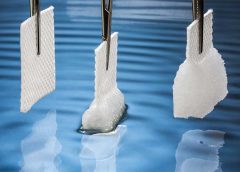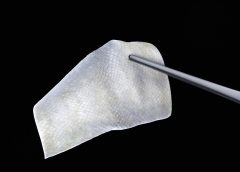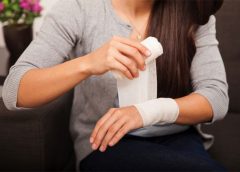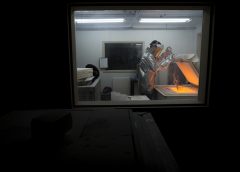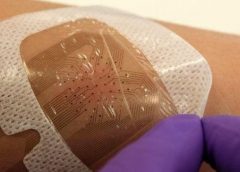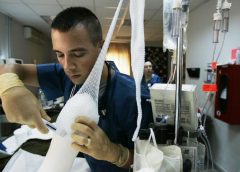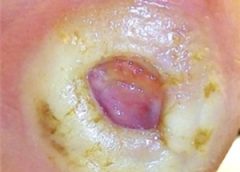The cutting-edge of wound care is a progressively flexible one, where textiles, foams, and films are applied to wound management technology with the goal of synergistic physiological function. These innately intuitive materials underpin the emerging medical solutions that practitioners and their patients are finding more effective than traditional wound care and closure methods. With an aging population more frequently seeking medical care and a surge in diabetes diagnoses, market analysts predict a continuing rise in demand for advanced wound care management products, fueling an annual industry growth rate of 6.4% over the next five years. (more…)
Read MoreSearch Results for: dressing
Fish Skin for Human Wounds: Iceland’s Pioneering Treatment
The FDA-approved skin substitute reduces inflammation and transforms chronic wounds into acute injuries.
Six hours north of Reykjavik, along a narrow road tracing windswept fjords, is the Icelandic town of Isafjordur, home of 3,000 people and the midnight sun. On a blustery May afternoon, snow still fills the couloirs that loom over the docks, where the Pall Palsson, a 583-ton trawler, has just returned from a three-day trip. Below the rust-spotted deck, neat boxes are packed with freshly caught fish and ice. “If you take all the skins from that trawler,” says Fertram Sigurjonsson, the chairman and chief executive officer of Kerecis Ltd., gesturing over the catch, “we would be able to treat one in five wounds in the world.” (more…)
Read MoreSmart bandage uses nanosensors to track how a wound is healing
Bandages are intended to keep a dressing secure and clean in order to reduce healing time and infection rate. However, they may be about to get a new use-case, courtesy of a project from the United Kingdom’s Swansea University Institute of Life Science.
What researchers there have been working on is a new smart bandage capable of tracking how a wound is healing and sending that data back to doctors, via 5G technology. To do this it would employ tiny “nanosensors” able to fit comfortably within the fabric of regular bandages. (more…)
Read MoreWound care technology invented at S&T hits marketplace
A glass-based wound care product that emerged from research by a doctoral student at Missouri University of Science and Technology has been approved by the U.S. Food and Drug Administration for human use and is now available on the commercial market.
Steve Jung laid the groundwork for the Mirragen Advanced Wound Matrix while earning a master’s degree in ceramic engineering and a Ph.D. in materials science and engineering at Missouri S&T. Jung is now chief technology officer at Mo-Sci Corp., a Rolla specialty glass manufacturer that continued the product’s development in collaboration with ETS Wound Care, also of Rolla. (more…)
Read MoreSmart bandages which tell doctor how wound is healing to begin trials
Smart bandages which can detect how well a wound is healing and send a progress report to the doctor will be trialled within the next year, scientists have said. The dressings are fitted with tiny sensors which can pick up blood clotting, or spot infections, and wirelessly send data back to a clinician. Swansea University, which is hoping to trial the bandages within 12 months, said the new technology could offer a personalised approach to medicine.
Currently patients with wounds are advised to return to the doctor in a certain amount of time. But each case may need a longer time to heal, or may have become infected before the visit. (more…)
Read MoreEducational Webinars
Webinars
Revealing Advanced Wound Care Market Growth Factors
At a time when governments are under pressure to reduce healthcare costs, the global advanced wound care market is growing, driven by an aging population and rising incidences of chronic wounds.
Advanced wound care products are typically used to manage complex wounds, including burns, chronic wounds and complex trauma and surgical wounds. Chronic and complex wounds represent one of the predominant challenges to global healthcare systems because they are hard to heal and expensive to treat. (more…)
Read MoreExudate amounts
BY: NANCY MORGAN, RN, BSN, MBA, WOCN, WCC, CWCMS, DWC
We’ve talked about types of exudate (drainage). Now let’s consider the amount of exudate in wounds, which is a key part of our assessment.
No exudate present: The wound is too dry.
Scant amount of exudate present: The wound is moist, even though no measurable amount of exudate appears on the dressing.
Small or minimal amount of exudate on the dressing: Exudate covers less than 25% of the bandage. (more…)
Wound exudate types
BY: NANCY MORGAN, RN, BSN, MBA, WOCN, WCC, CWCMS, DWC
What exactly is wound exudate? Also known as drainage, exudate is a liquid produced by the body in response to tissue damage. We want our patients’ wounds to be moist, but not overly moist. The type of drainage can tell us what’s going on in a wound.
Let’s look at the types of exudates commonly seen with wounds. (more…)
Read MorePalliative care patients
BY: NANCY MORGAN, RN, BSN, MBA, WOCN, WCC, CWCMS, DWC
The World Health Organization defines palliative care as care that affirms life and views death and dying as part of a normal process, intends neither to speed nor delay death, provides relief from pain and other distressing symptoms, and offers support to the patient and family. (more…)
Read MoreThink a Patient Has Rights? They Left.
by Dr. Michael Miller
There are few absolutes in my universe. I know that my youngest daughter will gleefully and with full malice (but humorously presented) find something to torment me about every time I see her; referrals from family practice docs arrive well marinated in multiple antibiotics with nary a diagnosis in sight (save for the ubiquitous “infection”); and that regardless of what I recommend, offer, beg, plead, or cajole, that the patient has the complete and total power to make their decisions regarding their care and who provides it. Unless they are deemed by multiple authorities to be incapable of making a decision, until the appropriate paperwork or an emergency situation exists mandating immediate lifesaving action, the ball bounces squarely in their court…or so I thought. (more…)
Read More
